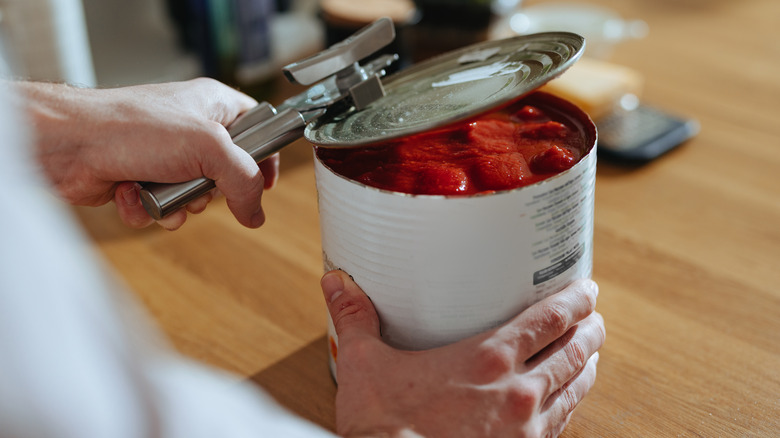The Arbitrary Reason Some Canned Goods Have Really Specific Weights
The next time you're in the canned foods section of your grocery store, pay close attention to the weights listed on the label. As observed by a keen-eyed consumer on Reddit, some canned goods feature non-standard weights like 14 ½ ounces, as opposed to a well-rounded number. According to a commenter in the thread, the reason for this odd number convention is merely "arbitrary." The person cites an excerpt from a book titled "Canning and How to Use Canned Foods," which was published in 1916. As explained in the book, cans were cut from large plates made of tin, and manufacturers aimed to derive a specific number of cans from each plate. This led to a standardized system that persists to this day.
The book's author, Arvill Wayne Bitting, also pointed out that, "The logical alternative of making the sheet of tin plate to such size as will build cans of a certain capacity does not seem to have been considered." However, another commenter offered a sensible reason for this apparent oversight. They mention that can manufacturers may have been "stuck with" a certain size of tin plates due to the machinery they used. Also, tin plate size may have been based on other factors, such as the dimensions of the vehicles used to haul plates.
How to convert canned food sizes when making recipes
Experimenting with older recipes is a fun and challenging pastime for home chefs. However, some recipes of yore feature can sizes instead of listing out measurements of certain ingredients. In this case, it helps to know exactly what the can size correlates to if you want to make tweaks to the recipe. Consider that many canned foods feature three-digit numbers, which list the diameter and height of the can itself. The first number lists inches, while the subsequent numbers communicate sixteenths of an inch. Accordingly, a can that's labeled as #303 is three inches in diameter and three-sixteenths of an inch in height.
While this three-digit number tells you something about the dimensions of the can itself, it's not very helpful when you're trying to convert a can size to a quantity of an ingredient. Fortunately, there are helpful conversion charts available, like the one from the University of Nebraska-Lincoln. In the case of the #303 can, you can expect a volume of 2 cups and a weight ranging between 15 and 17 ounces.
Do canned foods offer any benefits?
One obvious benefit of canned foods, regardless of weight, is their longevity. As explained by the USDA, canned goods can last years in many cases, depending on the type of food. The lifespan of canned vegetables with low levels of acidity and meats typically ranges from two to five years. As for canned tomatoes and other foods with high levels of acidity, these items can last as long as 18 months. Keep in mind that these timelines only apply when canned items are stored properly, meaning in a dry area of the home safeguarded against high temperatures.
While it's often claimed that canned foods are not as nutritious as their fresh counterparts, this isn't the case. According to Healthline, canned foods contain essential vitamins and nutrients, despite the impact of the heating process on certain elements (specifically, vitamins B and C, which can be leached away). The nutritional content of certain foods can even increase as a result of canning. This is certainly true of canned tomatoes and lycopene, as the powerful antioxidant becomes more plentiful after canning. While the sizes and weights of cans might not make much sense, the many benefits that canned foods offer definitely stand to reason.


